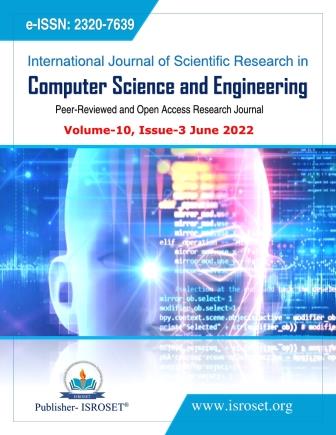Implementation of Machine Learning Model On SARS-Cov-2 Clinical Evidence
Keywords:
SARS-COV-2, Statistical, Neural Network, Optimization, Machine LearningAbstract
Computational strategies for machine learning (ML) have appeared their meaning for the projection of potential comes about for educated decisions. Machine learning algorithms have been connected for a long time in numerous applications requiring the discovery of antagonistic hazard variables. This ponder appears the capacity to anticipate the number of people who are influenced by the SARS-CoV-2 as a potential danger to human creatures by ML demonstrating. As an alternative to optimization, statistical, and neural network models, this research offers a relative analysis of machine learning and delicate computing models to anticipate the SARS-CoV-2 outbreak.Among a wide extend of machine learning models explored, three models appeared promising comes about .In this Module used parameters of entities cumulative total of cases and cumulative total of deaths reported globally in this module prediction. We are predicting the newly reported cases in past 24hrs, newly reported cases in past 7days and newly reported deaths in last 24hrs, newly reported deaths in past 7days, etc. In Machine learning it`s play`s a significance role in the prediction of covid 19 cases. Using these techniques easily identified SARS-COV-2 patient growth rate, death rate, Recovery rate, etc., in the Last 24 hours, 7 days, and also a mode of Transmission at countrywide. The models outcomes 93.6 accuracy. (Its show`s high amount of accuracy in testing .optimization module is useful to prediction of cases which are going happen in future).
References
Maier, B.F. Brockmann, D. Effective containment explains sub-exponential growth in confirmed cases of recent COVID-19 outbreak in Mainland China. medRxiv 2020.
Alimadadi A et al Artifcial intelligence and machine learning to fght COVID-19. American Physiological Society,2020, Bethesda.
Amar LA, Taha AA, Mohamed MY Prediction of the fnal size for COVID-19 epidemic using machine learning: a case study of Egypt. Infect Dis Model 5:622?634,2020.
Anastasopoulos C et al Development and clinical implementation of tailored image analysis tools for COVID-19 in the midst of the pandemic: the synergetic efect of an open, clinically embedded software development platform and machine learning. Eur J Radiol 131:109233,2020.
Arvind V et al Development of a machine learning algorithm to predict intubation among hospitalized patients with COVID-19. J Crit Care 62:25?30,2020
Assaf D et al Utilization of machine-learning models to accurately predict the risk for critical COVID-19. Intern Emerg Med 15(8):1435443,2020.
Detection of COVID-19 infection from routine blood exams with machine learning: a feasibility study. J Med Syst 44:135
Brunese L et al Machine learning for coronavirus COVID-19 detection from chest x-rays. Proced Comput Sci 176:2212.2221,2020.
Burdick H et al Prediction of respiratory decompensation in Covid-19 patients using machine learning: the READY trial. Comput Biol Med 124:103949,2020a
Burdick H et al Is machine learning a better way to identify COVID-19 patients who might beneft from hydroxychloroquine treatment? The Identify Trial. J Clin Med 9(12):3834.,2020b.
Wang P.W., Horby F.G., Hayden G.F. GaoA novel coronavirus outbreak of global health concern. Lancet.,2020.
Y. Bai, L. Yao, T. Wei, F. Tian, D.-Y. Jin, L. Chen, M. WangPresumed asymptomatic carrier transmission of COVID-19 JAMA (2020).
Y. Zhang, B. Jiang, J. Yuan, Y. TaoThe impact of social distancing and epicenter lockdown on the COVID-19 epidemic in mainland China: a data-driven SEIQR model study medRxiv (2020)
World Health Organization. Coronavirus disease (COVID-2019) situation reports. Available from: https://www.who.int/emergencies/diseases/novel-coronavirus-2019/situation-reports. Accessed 30 July 2020.
Zhang S, Diao M, Yu W, Pei L, Lin Z, Chen D. Estimation of the reproductive number of novel coronavirus (COVID-19) and the probable outbreak size on the diamond princess cruise ship: a data-driven analysis. Int J Infect Dis. 2020.
Rocklöv J, Sjödin H, Wilder-Smith A. COVID-19 outbreak on the diamond princess cruise ship: estimating the epidemic potential and effectiveness of public health countermeasures. J Travel Med. 2020.
S Ranjeeth*, T.P. Latchoumi and P Victer Paul, Optimal Stochastic Gradient Descent with Multilayer Perceptron Based Student`s Academic Performance Prediction Model, Recent Advances in Computer Science and Communications, 2020.
S Ranjeeth, T.P. Latchoumi, P Victer Paul, A Survey on Predictive Models of Learning Analytics, Procedia Computer Science, Volume 167, 2020,
Moulaei, K., Shanbehzadeh, M., Mohammadi-Taghiabad, Z. et al. Comparing machine learning algorithms for predicting COVID-19 mortality. BMC Med Inform Decis Mak 22, 2, 2022.
Imtyaz, A., Haleem, A., & Javaid, M. (2020). Analysing governmental response to the COVID-19 pandemic. Journal of Oral Biology and Craniofacial Research, 10(4), 504–513.
Lu, Y. (2019). Artificial intelligence: a survey on evolution, models, applications and future trends. Journal of Management Analytics, 6(1), 1–29, 2019.
Paritala, Venu & Reddy, Rajashekhar & Kalva, Sukesh. (2021). Journal of Applied Bioinformatics & Computational Biology Neglected Disdb: A Broad Internet Framework for Gathering And Analysing Data From Neglected Diseases.
Downloads
Published
How to Cite
Issue
Section
License

This work is licensed under a Creative Commons Attribution 4.0 International License.
Authors contributing to this journal agree to publish their articles under the Creative Commons Attribution 4.0 International License, allowing third parties to share their work (copy, distribute, transmit) and to adapt it, under the condition that the authors are given credit and that in the event of reuse or distribution, the terms of this license are made clear.







